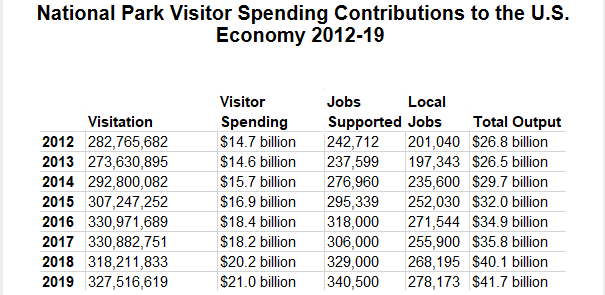
Interior Secretary David L. Bernhardt has announced the annual economic benefit of national parks to the U.S. and local economies last year was more than $41.7 billion.
In 2019, according to an Interior Department press release, visitor spending in communities near national parks supported 340,500 jobs. That figure represents a spending increase of $800 million from 2018, and the overall effect on the U.S economy grew by $1.6 billion. In the last five years, visitor spending has increased by $4.1 billion and the effect on the U.S. economy grew by $9.7 billion, the agency said.
“These treasured places provide respite and recreation for the American people,” Bernhardt said, “in addition to vital economic support to gateway communities across the country. The tremendous value of our national parks is undeniable as is the need to adequately maintain them, which is why President Trump has called on Congress to address the decades of deferred maintenance.”
According to the annual National Park Service report released Thursday, 2019 National Park Visitor Spending Effects, more than 327 million visitors spent $21 billion in communities within 60 miles of a park in the National Park System, the agency said. Of the 340,500 jobs supported by visitor spending, more than 278,000 jobs exist in communities adjacent to parks. The report includes statistics by park and by state on visitor spending and the number of jobs supported by visitor spending.
Lodging expenses account for the largest share of visitor spending totaling $7.1 billion in 2019, according to the Interior Department. The restaurant sector had the next greatest effects with $4.2 billion in economic output. Motor vehicle fuel expenditures were $2.16 billion with retail spending at $1.93 billion.
There are National Park System sites in all 50 states, the District of Columbia and the U.S. Territories of Puerto Rico, the Virgin Islands, American Samoa and Guam. Visitation varies across the country from Grand Canyon National Park in Arizona to Grand Portage National Monument in Minnesota.
For additional state-by-state information about national parks and how the National Park Service is working with communities, go to http://www.nps.gov/[statename], for example: http://www.nps.gov/virginia.
Hotlink: https://content.govdelivery.com/accounts/USDOI/bulletins/29012f2



